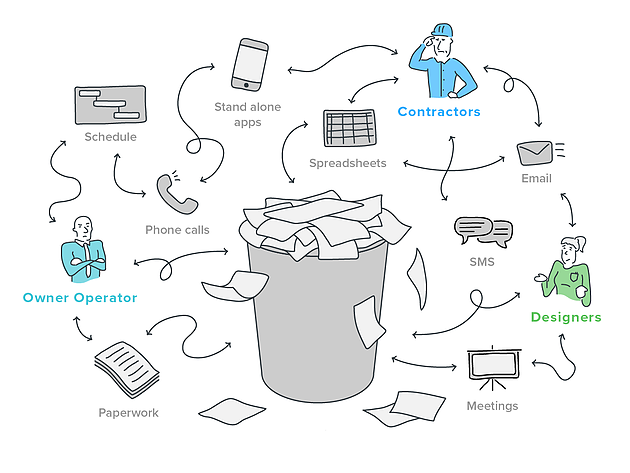Reliable Construction Document Management Solutions for each Project
Reliable Construction Document Management Solutions for each Project
Blog Article
Optimizing Project Collaboration: Architect's Best Practices in Building File Administration
In the detailed world of architectural projects, the efficient management of construction files stands as a keystone for success. Engineers, with their thorough focus to information and ingenious layout remedies, are tasked with orchestrating a harmony of stakeholders, resources, and timelines. Among this intricacy exists a vital question: exactly how can designers simplify collaboration procedures to enhance job results? By exploring crucial strategies such as leveraging cloud-based systems, establishing robust interaction methods, and ensuring data safety, engineers can boost their file management techniques to new heights.
Leveraging Cloud-Based Platforms
Leveraging cloud-based systems is an essential method for contemporary engineers in optimizing construction document monitoring procedures. By transitioning from traditional paper-based systems to cloud services, engineers can enhance collaboration, improve paper access, and boost general job performance. Cloud-based platforms supply designers the ability to store, share, and upgrade building and construction files in real-time, guaranteeing that all employee have access to the most present details regardless of their place. This ease of access promotes seamless communication and coordination among job stakeholders, bring about fewer errors and hold-ups in the building and construction process.
In addition, cloud-based systems supply a protected environment for keeping sensitive task info, offering file encryption, regular backups, and user permission setups to secure information integrity. Engineers can likewise profit from the scalability of cloud remedies, enabling them to readjust storage space capacity and functionality based upon task needs. In general, leveraging cloud-based platforms empowers engineers to enhance their building file management procedures, driving better partnership, performance, and success in their tasks.
Applying Variation Control Solution
Having actually developed the benefits of cloud-based systems in building record monitoring, designers can currently boost their record control procedures by carrying out Variation Control Solution. Variation Control Systems (VCS) are vital tools that track modifications in documents, guaranteeing that employee are always collaborating with the most recent and most exact information. By carrying out VCS, designers can preserve a centralized repository where all job files are kept, enabling smooth partnership while lessening the risk of errors and variation problems.
This feature is specifically important in construction projects where layout models and modifications are common. This transparency not only enhances liability however likewise aids in fixing disagreements or discrepancies that might develop throughout the task lifecycle.
Developing Communication Protocols
To ensure effective and efficient project control, designers need to establish clear and durable interaction methods within their building and construction document administration processes. This platform can be a project management software program, email strings, or cloud-based storage remedies.
Additionally, interaction methods must also include standards on exactly how to manage problems, adjustment orders, and urgent issues that might develop throughout the task lifecycle. Developing a structured technique to communication makes certain that all stakeholders get on the same web page, advertises openness, and eventually adds to the effective completion of the building and construction project.
Utilizing BIM Software for Control
BIM software plays a critical function in boosting control among project staff member in the construction industry. Structure Information Modeling (BIM) helps with cooperation by offering a centralized system where designers, engineers, professionals, and various other stakeholders can interact in a worked with way. Through BIM software application, project participants can access and upgrade a common design that his explanation includes in-depth info concerning the structure layout, building elements, and task timetables.

In addition, BIM software program enables real-time collaboration and interaction amongst employee, despite their physical area. With cloud-based BIM platforms, job stakeholders can access the most up to date job information, track modifications, and make informed choices immediately. Overall, leveraging BIM software program for sychronisation enhances job efficiency, performance, and eventually leads to successful task results.
Ensuring Information Protection and Conformity
In the world of building document management, guarding information integrity and making certain governing compliance are critical factors to consider for designers and other task stakeholders. Architects must implement robust safety and security steps to protect sensitive additional reading job info from unauthorized access or violations. Using protected cloud storage options with encryption procedures and gain access to controls can help alleviate threats connected with information burglary or loss. Regularly updating software application and systems, conducting safety and security audits, and giving personnel training on information safety best methods are vital steps in keeping a protected atmosphere for construction record monitoring.

Conclusion
In conclusion, engineers can enhance project partnership in building and construction paper management by leveraging cloud-based platforms, implementing variation control systems, developing communication procedures, making use of BIM software program for sychronisation, and making sure information security and compliance. These best practices aid improve the building and construction process, boost communication among job stakeholders, and boost performance in job distribution. By following these guidelines, architects can properly handle building records and help with effective task results.
Through BIM software program, task individuals can access and update a common design that has detailed details concerning the building layout, construction parts, and job timetables.
Via cloud-based BIM platforms, task stakeholders can access the latest job information, track modifications, and make informed choices quickly - construction document management. On the whole, leveraging BIM software application for sychronisation boosts task effectiveness, performance, and inevitably leads to successful task results
In conclusion, engineers can enhance job collaboration in building paper administration by leveraging cloud-based platforms, implementing version control systems, establishing interaction protocols, utilizing BIM software application for control, and making certain information security and conformity. These ideal practices assist improve the construction process, boost communication among project stakeholders, and improve effectiveness in task distribution.
Report this page